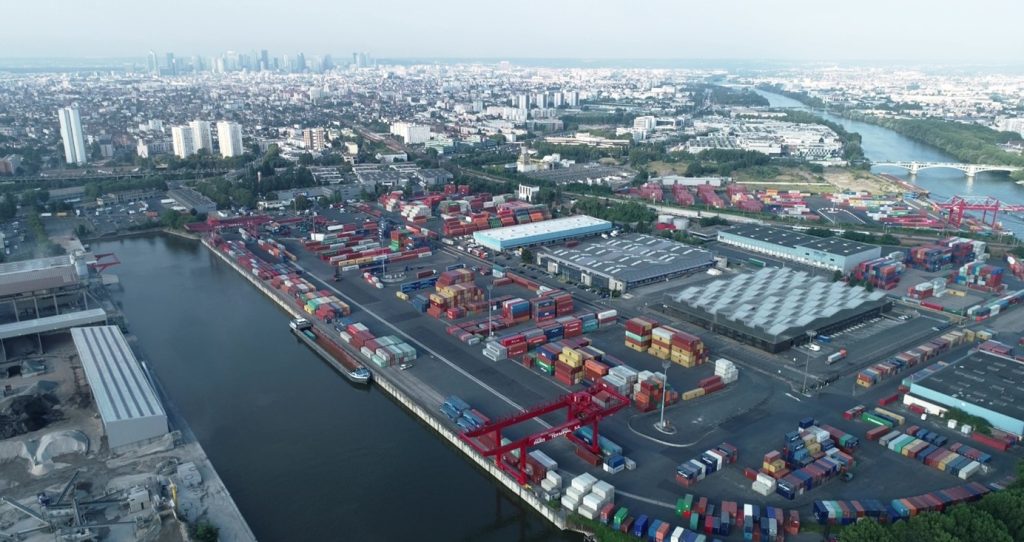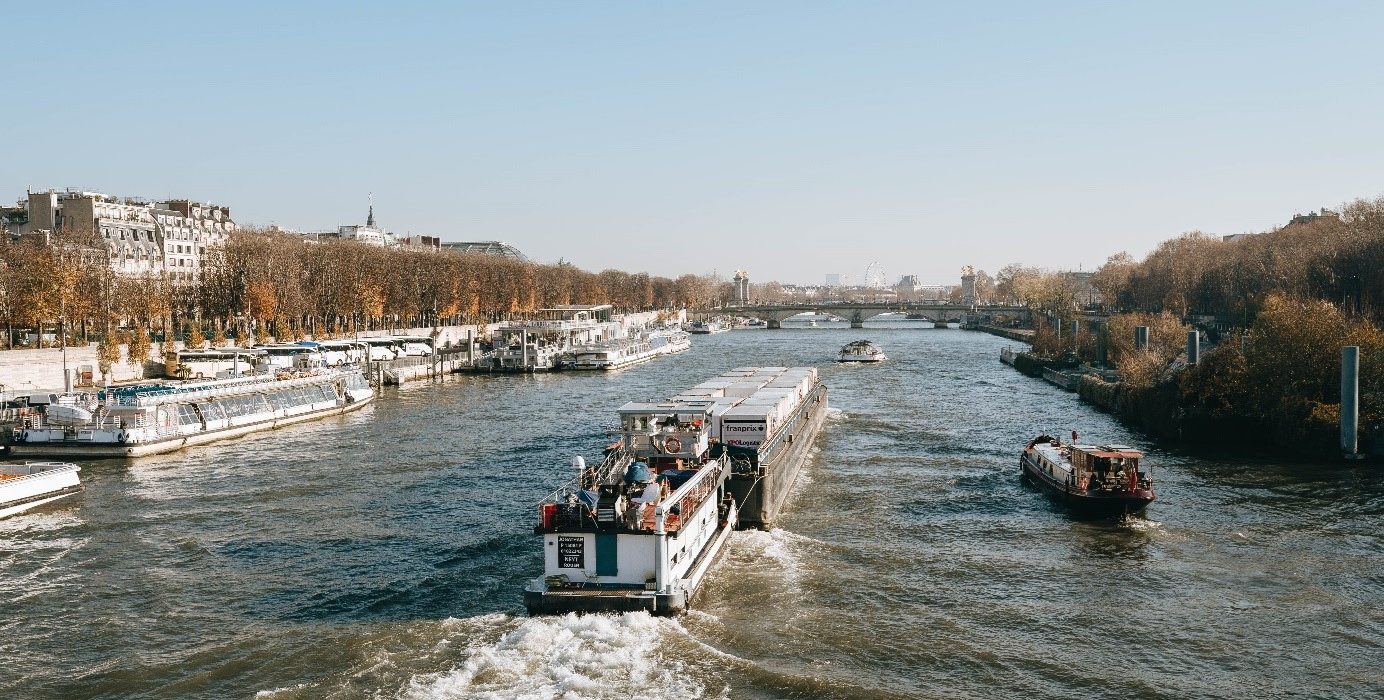As one of the major European metropolises, Paris has high logistical requirements. With 3,878 inhabitants per square kilometre, Paris is the most densely populated metropolis on the European mainland. This poses major challenges for road transport and restricts the reliability and flexibility of goods transport by road with an increase in e-commerce business.
This is why the City of Paris, the Ile de France, VNF and HAROPA (the leading port in France) are working together to enable stakeholders to transfer their goods traffic to waterways. This not only applies to the transport of building materials, such as the construction of the Olympic Village, the reconstruction of Notre Dame or the construction of the Grand Paris Express, but also to the transportation of retail products.
Two good practice examples from the retail sector are waterborne transport services on behalf of Ikea and Franprix in Paris. These examples have been successful in shifting retail deliveries to inland waterways. Various success factors contributed to the development of these cases, such as the collaboration with major clients and the coordination of stakeholders within and outwith the logistics pipeline. One important stakeholder is the city of Paris, which offers important infrastructure with many historic quays in the city centre such as at the port of Bercy, as well as HAROPA, who offered port locations such as Gennevilliers and Bonneuil-sur-Marne.

Paris Terminal SA in Gennevilliers – a multimodal distribution point for several logistical services(Source: PTSA)

Cargo Handling of XPO Franprix at La Bourdonnais (Source: XPO Franprix)
Some interesting key facts:
| Name of service | Retail Paris |
| Operator | Sogestran and Box2Home for Ikea, owner-operators/Paris Terminal SA for Franprix |
| Market Segment | Passenger Transport |
| Region | France (excl Rhine) |
| Launch year | 2012 (Franprix), 2021 (Ikea) |
| Barge Capacity | 2000 t (FP) and 1200 t (Ikea) |
| Fleet Size | 1 per case |
| Crew | 1-3 |
| Port equipment | Reach stackers |
| Service frequency | 5 days per week (FP), 7 days per Week (Ikea) |
| Societal benefits (e.g. mitigated emission) | Saving 300,000 truck kilometers for IKEA deliveries |
Some more insights about the service
The Franprix service has an advantageous location, as a Franprix logistics centre is located near the water in the port of Bonneuil-sur-Marne on the Quai du Rancy. From there, goods can be shipped first via the Marne and then via the Seine to the Port de la Bourdonnais near the Eiffel Tower. This route covers around 17.7 kilometres and takes around 2.5 hours. The Franprix service uses containers in which goods are transported and unloaded with the help of reach stackers (one at La Bourdonnais and two at Bonneuil-sur-Marne, KALMAR ECO-Model) and then emptied.
The last mile operation is carried out with twelve trucks for more than 300 Franprix stores. On the one hand, noise pollution can be caused by the transshipment process, and on the other hand, logistics services compete with tourist services for the occupancy of berths in the city centre. This requires an adjustment to the timing of logistics. The road transport service for Franprix travels throughout the day from their warehouse to the port, with a cut-off at 5 o’clock in the afternoon, where the barge starts sailing from the Port Bonnueil sur Marne, where around 45 containers are loaded (maximal capacity 48 boxes). The journey to the city centre takes around 2.5 hours. In the evening, the ship anchors at the port de la Bourdonnais.
The following day at 5 a.m., the barge is offloaded, and the trucks are loaded for the last mile operation, which supplies the 300 Franprix shops in Paris. Trucks drive back with the empty boxes, and these are loaded onto the barge. The vessel then leaves the port of La Bourdonnais around noon, sailing back to Bonneuil, discharging the empty containers at the port of origin, and loading the full containers, so that the process can start all over again. The involved actors in Franprix project are XPO logistics, SCAT, and Terminaux de Seine (a subsidiary of Paris Terminal).
The Ikea service also faces similar challenges, but it is possible to operate a night service in the port of Gennevilliers so that Ikea deliveries reach the end customer in a time window between 5 and 7 a.m. and 7 to 9 a.m., thus ensuring delivery reliability. Various partners are involved in the logistical pipeline. Box2Home is responsible for transport and handling operations in the port of Gennevilliers. Sogestran is responsible for transport and handling operations on the waterway with the Alpha 01. At the handling operation in the port of Bercy in the city centre, Box2Home is again responsible for the handling operation and Trusk for the last mile operation.
This means that various companies are interlinked in the supply chain. Constant and mutual communication is therefore of great importance. This also shows a close integration with a well-coordinated logistics concept. The Franprix case also shows that experience has been gained and the logistics concept has been optimised over more than ten years.
Lessons learned and roll-out-potential
The waterborne transport services implemented in Paris, particularly for Franprix and Ikea, showcase promising success stories with notable benefits and some challenges that provide valuable lessons learnt for future projects or services.
Collaboration between the City of Paris, Ile de France, VNF and HAROPA facilitated the transition of goods transport to waterways, demonstrating the importance of multi-stakeholder partnerships in implementing sustainable logistics solutions. The use of historic quays in the city centre as loading points for last-mile transport and existing ports such as Gennevilliers and Bonneuil-sur-Marne in the joint planning of the participating stakeholders promotes the success of subsequent transport solutions in urban areas. Adaptable logistics concepts, including night operations and well-coordinated supply chains involving multiple partners, ensured reliable and timely deliveries to the city centre, enhancing service efficiency. Significant reduction in CO2 emissions compared to road transport, along with compliance with regulatory environmental restrictions, positioned waterborne transport services as environmentally friendly alternatives, appealing to both businesses and regulators.
Constraints such as limited space, time restrictions for loading, and protection of historical monuments in the city centre including historical quays posed challenges for infrastructure development and operational logistics, requiring innovative solutions to overcome. Administrative requirements related to environmental protection and land consumption necessitated careful planning. While the services demonstrated success in their current operations, further expansion and replication of similar initiatives may require addressing evolving market demands, particularly in response to changing consumer behaviour in e-commerce.
The demonstrated success of the Franprix and the Ikea services underscores the scalability of waterborne transport solutions, with potential for replication in other urban areas. Ongoing innovation and optimisation of logistics concepts, including cargo handling and vessel design, will be essential to address emerging challenges and to maintain competitiveness. Emphasising customer-specific advantages, such as reliability, environmental sustainability, and brand visibility, will be key to driving market adoption and ensuring the long-term viability of waterborne transport services.
